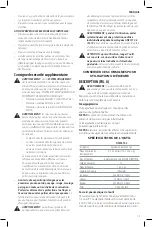
English
3
holstering or hanging tool, or when preparing
work surface for fastening operation.
• This tool produces SPARKS during operation.
NEVER use the tool near flammable substances,
gases or vapors including lacquer, paint, benzine,
thinner, gasoline, adhesives, mastics, glues
or any other material that is ‑‑ or the vapors,
fumes or byproducts of which are ‑‑ flammable,
combustible or explosive. Using the fastenerer in
any such environment could cause an EXPLOSION
resulting in personal injury or death to user
and bystanders.
WARNING: After driving a fastener, tool may
bounce back (“recoil”) causing it to move away
from the work surface. To reduce risk of injury
always manage recoil by:
• Always maintaining control of tool.
• Allowing recoil to move tool away from
work surface.
• Not resisting recoil such that tool will be forced
back into the work surface. In “Contact Actuation
Mode,” if workpiece contact is allowed to
re‑contact work surface before the trigger is
released, an unintended discharge of a fastener
will occur.
• Keeping face and body parts away from tool.
WARNING:
Disconnect tool:
• When not in use.
• When performing any maintenance or repairs,
• When clearing a jam.
• When elevating, lowering or otherwise moving
tool to a new location.
• When tool is outside of the operator's supervision
or control.
• When loading or removing fasteners from
the magazine.
WARNING:
When maintaining the tool:
• Always shut off air supply, and disconnect tool
from air supply when not in use.
• When working on air tools note the warnings in
this manual and use extra care when evaluating
problem tools.
Additional Safety Warnings
WARNING:
Do not use this product to fasten electrical
cables. Fastening electric wires / cables could result in
electric shock or serious harm.
WARNING:
Make sure there are no electrical cables,
gas pipes, etc. that could cause a hazard if damaged
by use of the tool.
WARNING:
This tool is not intended for use in
potentially explosive atmospheres and is not insulated
from coming into contact with electrical power.
• Use the
D
e
WALT
pneumatic tool only for the purpose for
which it was designed.
• Do not use the tool as a hammer.
• Always carry the tool by the handle with hand off
trigger/ triggers.
• Never lift, pull, lower, or carry the tool by the air hose.
• Whipping hoses can cause severe injury. Always check for
damaged or loose hoses or fittings.
• Never direct compressed air at yourself or anyone else.
• Compressed air can cause severe injury.
• Do not alter or modify this tool from the original design or
function without approval from
D
e
WALT
.
• Never clamp or tape the trigger in an actuated position.
• Ensure tool is always safely engaged on the workpiece and
cannot slip.
• Never leave a tool unattended with the air hose attached.
TO PREVENT ACCIDENTAL INJURIES:
• Never place a hand or any other part of the body in
fastener discharge area of tool while the air supply
is connected.
• Never actuate the tool unless nose is directed at the work.
• Do not actuate the tool while loading.
• Keep hands and body parts away from the discharge
area of the tool. While in use NEVER grasp the tool by the
magazine or canister, a mis‑driven fastener can exit the
nose causing injury.
Additional Safety Information
WARNING: ALWAYS
use safety glasses. Everyday
eyeglasses are NOT safety glasses. Also use face or
dust mask if cutting operation is dusty. ALWAYS WEAR
CERTIFIED SAFETY EQUIPMENT:
• ANSI Z87.1 eye protection (CAN/CSA Z94.3),
• ANSI S12.6 (S3.19) hearing protection,
• NIOSH/OSHA/MSHA respiratory protection.
WARNING:
Some dust created by power sanding,
sawing, grinding, drilling, and other construction
activities contains chemicals known to the State
of California to cause cancer, birth defects or
other reproductive harm. Some examples of these
chemicals are:
• lead from lead‑based paints,
• crystalline silica from bricks and cement and other
masonry products, and
• arsenic and chromium from chemically‑
treated lumber.
Your risk from these exposures varies, depending on
how often you do this type of work. To reduce your
exposure to these chemicals: work in a well ventilated
area, and work with approved safety equipment, such
as those dust masks that are specially designed to
filter out microscopic particles.
•
Avoid prolonged contact with dust from power
sanding, sawing, grinding, drilling, and other
construction activities. Wear protective clothing and
wash exposed areas with soap and water.
Allowing
dust to get into your mouth, eyes, or lay on the skin may
promote absorption of harmful chemicals.






































